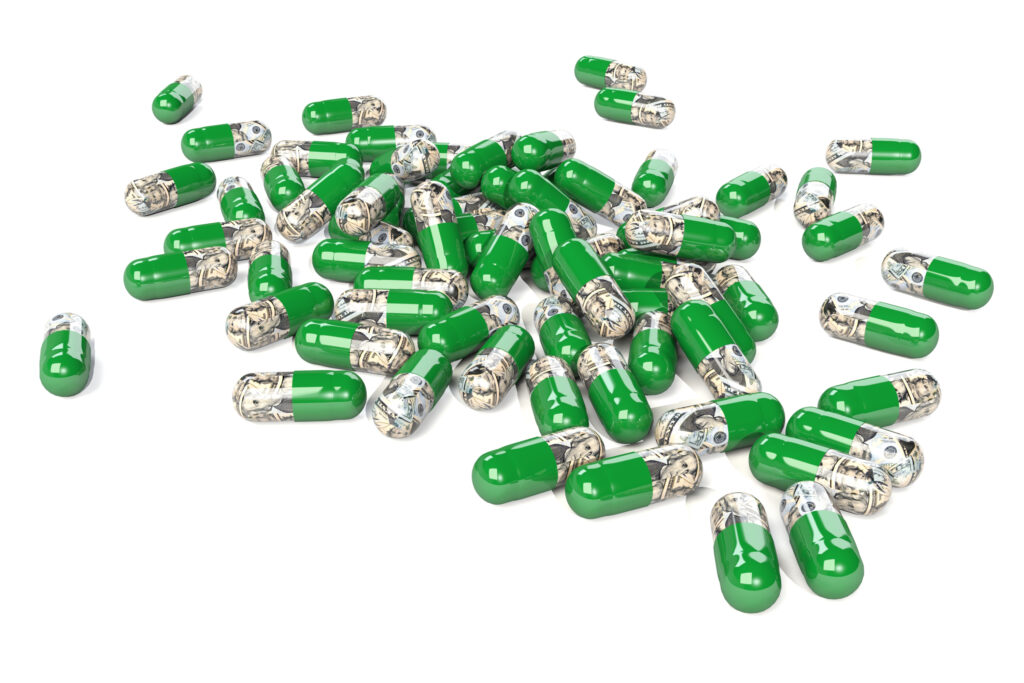Susannah Rose and her colleagues recently published a study in JAMA Internal Medicine, which investigated the financial conflicts of interest (FCOI) of patient advocacy organizations (PAOs) in the United States. PAOs include organizations like the National Alliance on Mental Illness, the American Pain Foundation, the American Heart Association etc. Their survey results concluded that 165 of 245 (67.3%) of the organizations who responded endorsed receiving pharmaceutical industry funding and 19 of 160 (11.9%) received more than half of their funding from the industry.
This study is important given the role that PAOs play in the current healthcare environment, which range from service provision at the individual patient level to systemic decision making nationally and internationally. PAOs could be at same risk for bias when there is a financial conflict of interest (FCOI) that has been documented in the areas of research publication and physician decision making.

In this study, a random sample of 439 PAOs was selected and mailed and eventually 298 surveys were returned. The data were collected in 2013-14. A majority of the PAOs were tax-exempt nonprofit organizations. Their activities ranged from “participating in educational activities (286 1), fundraising (277 2), interacting with patients and families (270 3), participating in research (233 4), and engaging in policy and advocacy activities”. The three most common reported fundraising activities were individual donations, followed by corporate donations and fundraising events. Of the 245 organizations that answered the question related to industry funding, 165 (67.3%) received such funding. A smaller subset of 21 (8.8%) received more than $1 million. In terms of their conflict of interest policies, 175 of 274 (63.9%) organizations have a written conflict of interest policy whereas 73 of 284 (25.7%) have policies for publicly disclosing FCOI.
In their discussion, the researchers note,
“The largest proportion of industry funding was derived from the pharmaceutical, device, and biotechnology sector (median, 45%). Such dependence on the financial support of companies whose interests may not always align with those of the organizations’ constituents has important implications for PAOs.”
Additionally, around 8% of respondents admitted to feeling pressure to conform to the positions of interests that aligned with their industry funders. Ray Moynihan and Lisa Bero in a commentary in the same issue note that even though Rose et al. could not prove bias, this study highlights concerns about the ability of groups who receive money from industry to function independently. An example of potential industry influence they point out is the “Even the Score” drug-company funded “patient advocacy” campaign that helped win FDA approval for the controversial “female Viagra” flibanserin.
The limitations of this study were the potential for response bias or nonparticipation of PAOs with extensive or low industry ties, the chance of a social desirability bias, and a reliance on self-report as opposed to direct examination of funding sources or actions. Despite these limitations, the researchers believe their results represent a valid problem and recommend greater transparency or reports of FCOIs by PAOs on their websites, the development of more stringent FCOI policies or potentially “disengaging entirely from industry.”
Moynihan and Bero echo the sentiment that PAOs should be free of conflicts of interest, especially given that in the case of flibanserin, “groups like the National Women’s Health Network refused to support the company-sponsored ‘Even the Score’ campaign to get the drug approved, due to concerns about its lack of meaningful benefits and serious, potentially fatal harms.”
****
Rose, S. L., Highland, J., Karafa, M. T., & Joffe, S. (2017). Patient advocacy organizations, industry funding, and conflicts of interest. JAMA Internal Medicine. doi:10.1001/jamainternmed.2016.8443 (Abstract)















Well, well, nothing new under the sun?
If i recall well (i have the book at my side), seems a certain Mr. Whitaker… and a certain Miss Lisa, published at 2015 a volume called:
“… UNDER THE INFLUENCE”.
Seems some money… at least one… 100 United States dollar… is in at the cover 🙂
In a pharma package of pills. Surprise, surprise!
So… is kind a “new wallet”?
Now… if instead of: “Their survey results concluded that 165 of 245 (67.3%) of the organizations who responded endorsed receiving pharmaceutical industry funding and 19 of 160 (11.9%) received more than half of their funding from the industry.”
… if instead of “pharmaceutical industry”… was: “Tobaco Industry”… i imagine people would say: they are corrupt to the bone.
…………………
Now, some people are very naif.
They should listen to some whitle blowers that worked with the Pharma, looking to get psychiatrists to prescribe the pills of the brand they worked. These programs were already made and went at the USA TV. It worked. They took doctors to exotic places, they payed their expenses. And when the same doctors went home after their “meetings” at Asia… they prescrived… and prescrived. Worked.
Take this example…. Is not true anymore, as the wikipedia page has changed.
1 Acadia
2 Alkermes
3 Allon Therapeutics
4 AstraZeneca
5 Bioline
6 Bristol-Myers Squibb
7 Cephalon
8 Eli Lilly
9 Forest Laboratories
10 GlaxoSmithKline
11 Hoechst AG
12 Hoffmann-La Roche
13 Intra-Cellular Therapies
14 Janssen
15 Lundbeck
16 Medscape
17 Merck
18 Novartis
19 Organon
20 Ortho-McNeil-Janssen
21 Otsuka
22 Pfizer
23 Pierre Fabre
24 Psychogenics
25 Repligen Corporation
26 Sepracor
27 Solvay
28 Targacept
29 Upjohn Pharmacia
30 Wyeth
Now… who was in bed with those 30 women?
I will quote the english wikipedia: “This page was last modified on 26 September 2016, at 19:36
“In 2006, Lieberman co-signed a letter to the editor of The Wall Street Journal with around thirty other doctors. In the letter, disclosed honoraria, consulting fees, research grant support from AstraZeneca, Bristol-Myers Squibb, Upjohn Pharmacia, Novartis, Eli Lilly, Janssen, Pfizer, Hoechst AG, and AstraZeneca. He also listed as corporate speakers bureaus AstraZeneca, Janssen, Eli Lilly, and Pfizer.[7] Lieberman disclosed in 2007 in the journal Primary Psychiatry that he was a consultant to Eli Lilly and Pfizer. He was on the advisory boards of AstraZeneca, Eli Lilly, GlaxoSmithKline, Lundbeck, Organon, and Pfizer. He has a patent from Repligen Corporation. Lieberman received research support from Acadia, Bristol-Myers Squibb, GlaxoSmithKline, Janssen, Merck, Organon, and Pfizer.[8] In 2009, Lieberman disclosed grants from Allon, Forest Laboratories, Merck, Pfizer, AstraZeneca, Bristol-Myers Squibb, Cephalon, GlaxoSmithKline, Janssen, Otsuka, Solvay, and Wyeth to the American College of Neuropsychopharmacology for their annual meeting in which he participated.[9] In 2011, his disclosure at Medscape of relevant financial relationships says he served on the advisory board of Bioline, GlaxoSmithKline, Intra-Cellular Therapies, Eli Lilly, Pierre Fabre, and Psychogenics, and that he received research grants from Allon Therapeutics, GlaxoSmithKline, Ortho-McNeil-Janssen, Merck, Novartis, Pfizer, Sepracor, and Targacept.[10] He also disclosed in 2013, as a member of the psychiatry editorial board at Medscape, that he received research grants from Allon, Novartis, Sepracor, and Targacept; and he served on the advisory boards at Bioline, Intra-Cellular Therapies, Pierre Fabre and Psychogenics.[11] In additional disclosures at Medscape in 2013, he received research grants from Allon, GlaxoSmithKline, Eli Lilly, Merck, Novartis, Pfizer, Psychogenics, Hoffmann-La Roche, Sepracor, and Targacept, and he served on the advisory board of Alkermes, Bioline, Intra-Cellular Therapies, Pierre Fabre, and Psychogenics.[12]
CATIE study”
…………………
Oh. That Lieberman.
THE Jeffrey A. Lieberman. The Psychiatrist. The “anti-depressants-are-just-like-taking-insulin-for-diabetes (Lieberman)”
Look, again (today) at the wikipedia:
https://en.wikipedia.org/wiki/Jeffrey_Lieberman
Much shorter, yes?!
Pharma “influence” is gone, yes?
I wonder why? Thirty (30) “women”?
…………………
The same is valid for the DSM-5.
The people who made had… a tiny 69% of them… “influences”. From Pharma. Even went up from the DSM-IV.
Quote: “The financial association of DSM-5 panel members with industry continues to be a concern for financial conflict of interest.[61] Of the DSM-5 task force members, 69% report having ties to the pharmaceutical industry, an increase from the 57% of DSM-IV task force members.”
link:
The financial association of DSM-5 panel members with industry continues to be a concern for financial conflict of interest.[61] Of the DSM-5 task force members, 69% report having ties to the pharmaceutical industry, an increase from the 57% of DSM-IV task force members.[61]
…………………
So… “To be naif, or not to be naif…” 🙂
Report comment
Forgot the link to the wikipedia of the DSM-5:
https://en.wikipedia.org/wiki/DSM-5
Report comment
I’m sure we are all shocked. NAMI funded by industry? I bet you don’t believe in Santa either, do you? 🙂
Report comment
Patient Advocacy Groups funded by Big Pharma?
Most Autism and learning disability groups are defensive organizations funded by the parents.
Shocked to find that gambling is going on in here.
https://www.youtube.com/watch?v=HMIyDf3gBoY
Nomadic
If you want to post somewhere not funded by anyone, and if you want to move from talk to action, please join:
http://freedomtoexpress.freeforums.org/index.php
Report comment
Good to see some hard numbers about big pharma’s funding. I wish someone did a similar study here in Europe.
Report comment
Quote: “I wish someone did a similar study here in Europe”.
……………..
Your “whish” reminded me a comparation in a book: “Ridiculous Dietary Allowance”. Is about vitamin C. Wrote by Dr. Steve Hickley and Dr. Hillary Roberts. 2004.
At pages: 123, 124, 125 it lists the “declarations of interests”, of the UK expert comittee on the safety of vitamins and minerals. That comittee was made by twelve (12) professors and doctors.
Of those 12, a “tiny” 10 members… had… how should we say…? “Influences” (a euphemism).
10 out of 12 is a mere… 83,3% (in the best case), of “influenced”.
2 declared “no other interest”, and yet… if you have read “Anatomy of a epidemic”…
I cant scan and post a picture of those 3 pages, and is too long to type.
……………..
I will just quote the “other interests” (a tiny little… 17 interests), of one of that UK expert comittee, Donald Davies:
1) Astazeneca
2) Bayer Pic
3) Bristol Myers Squibb
4) Curis (USA)
5) Glaxo Wellcome
6) Lilly Research
7) Merch Sharp & Dohme
8) ML Laboratories
9) Orion-Farmos
10) Pfizer
11) Rhone-Poulenc Rorer
12) Roche
13) Sanofi winthrop
14) Schwarz Pharma
15) Servier
16) SmithKline Beecham
17) Solvay
And you see… that was about: vitamin C.
One can think: Pharma has bougth them/owns them?
……………..
What happened when a certain wistle blower (that happened to be a world class expert), when he told publicly a few things about the Big-Bad-Pharma?
Pharma tryed to cut any and all money arriving to him, and warned all his contacts that if they knew what was good for their health… to stay away from him.
So… the trend:
a) People like Robert Whitaker are a: “menace to society” (Lieberman).
b) People who testify in court against Pharma/write the truth… get no funds for any research. May lose their job. Get disciplined. Get in troubles.
c) And yet… a few folks… get payed, have: 17… or 20… or 30 “influences”.
Some get payed 10.000 United States dollars (or so), for 1 tiny speach.
OMG… is that even possible? 🙂
Of course not… is a lie spread by those anti-psychiatry folks 🙂
All is well.
Report comment